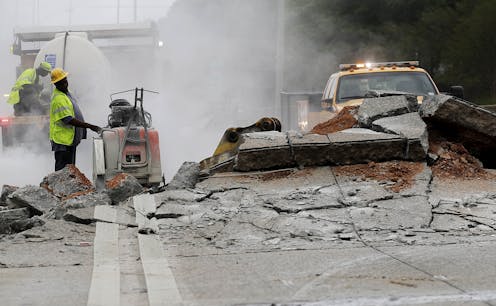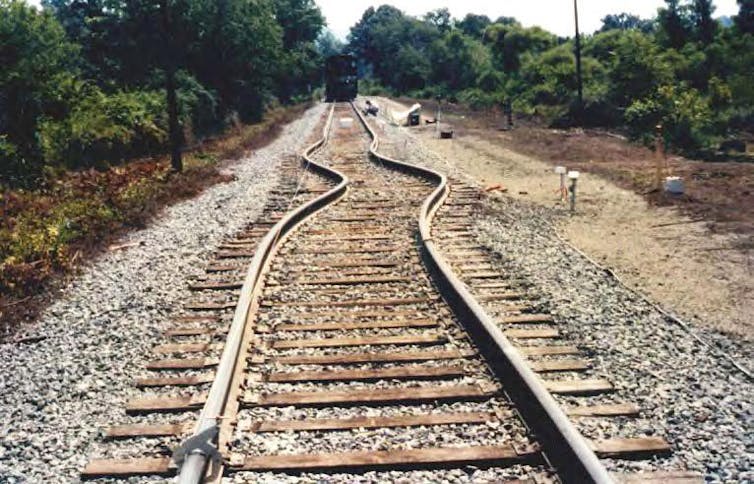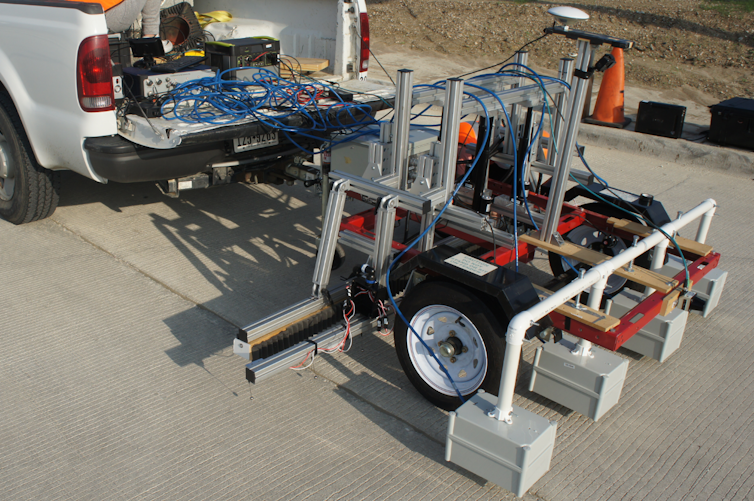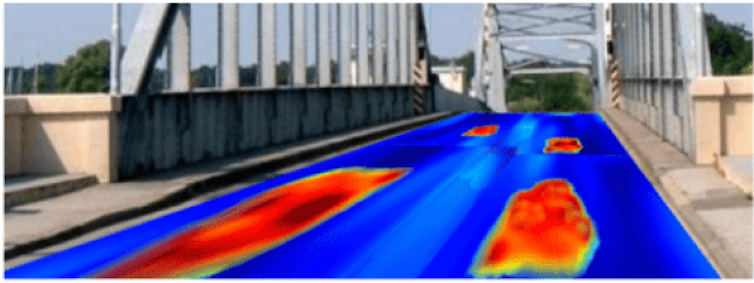Stuck bridges, buckling roads − extreme heat is wreaking havoc on America’s aging infrastructure
A civil engineer explains why roadways and rails warp and crack in the heat − and points to some innovative ways to keep the US transportation system healthy as long as possible.

Summer 2024’s record heat is creating problems for transportation infrastructure, from roads to rails.
New York’s Third Avenue Bridge, which swings open for ship traffic on the Harlem River, was stuck for hours after its metal expanded in the heat and it couldn’t close. Roads have buckled on hot days in several states, including Washington and Wisconsin. Amtrak warned passengers to prepare for heat-related problems hours before a daylong outage between New York and New Jersey; the risks to power lines and rails during high temperatures are a growing source of delays for the train system.
It doesn’t help that the worsening heat is hitting a U.S. infrastructure system that’s already in trouble.
The American Society of Civil Engineers gave U.S. infrastructure an overall grade of C- in its latest national Infrastructure Report Card, released in 2021. While there has been some improvement – about 7.5% of U.S. bridges were in poor condition, compared with over 12% a decade earlier – many bridges are aging, making them difficult to maintain. Forty percent of the road system was considered in poor or mediocre condition, and maintenance costs have substantially increased.
The rate at which a bridge or road deteriorates depends not only on the materials and construction methods used but also on the climate during the structure’s life span. Extreme heat, in particular, significantly affects transportation infrastructure. As climate change progresses, the frequency and intensity of heat waves are expected to increase, exacerbating these issues.
I lead the Smart Infrastructure and Testing Laboratory at the University of Texas at Arlington, where my team works on ways to better monitor the structural health of infrastructure. Here’s why infrastructure struggles in the heat – and how engineers are innovating to help extend its life.
Buckling highways pose a hazard for drivers
When a road is built, it is cut into segments to create space for the pavement to expand during high heat or to contract in the cold. Without that space, the pavement can buckle when the road material heats up. Buckling of concrete pavement has become a serious problem in several states.
Pavement becomes vulnerable to buckling for a number of reasons. The roadway’s design, the materials it is made out of, the climate when it was built and the weather during its lifetime can affect its life span, as can damage to the road and improper repairs.
Extreme temperatures and heavy precipitation can cause significant damage to roadways and jeopardize the structural integrity of rail systems. Additionally, sea-level rise is accelerating coastal erosion that can undermine roads and rail lines. The deterioration of pavement leads to traffic delays and damaged vehicles. And, most critically, it can cause traffic accidents.
Hot rails can expand and also buckle
Rail expansion is another significant concern, especially with continuous welded rails like the main lines that trains use.
When temperatures rise, rails expand due to the heat. This expansion can create high pressure and tension within the rail material. Combined with the forces exerted by moving trains, this pressure can cause the tracks to buckle to the side and become misaligned. It is sometimes referred to as a “sun kink.”
Buckling rails are a serious safety hazard that can cause derailments. That’s one of the reasons Amtrak slows its speed in extreme heat, often leading to schedule delays. Washington, D.C.’s Metro cuts its trains speed to a maximum of 35 mph once rails reach a temperature of 135 degrees Fahrenheit (57 degrees Celsius).

Predicting these thermal stresses can be challenging. Rail temperature measurements alone are not enough, because there are many unknown factors related to the track’s structure and how it moves. This makes it difficult to accurately forecast how much the rails will expand or contract.
Engineers can reduce rail expansion risk by using heat-resistant materials, such as hypereutectoid rail steel and martensite rail steel, adjusting track design and ensuring timely repairs.
To prevent roadways from buckling, engineers also have protective measures, such as using single-cut sawed joints filled with sealant to provide flexibility while keeping water out. They can also implement cold weather concreting practices that avoid pouring concrete during low temperatures or on cold bases, and they can use stronger and more durable concrete. Performing timely repairs when pavement cracks and becomes damaged can also help avoid buckling.
Keeping infrastructure healthy
Infrastructure health is similar to human health: If doctors detect problems such as tumors or cancer only in the later stages, it is often too late. Like human bodies, infrastructure needs to be maintained from the beginning to reduce costs and increase the potential for effective rehabilitation.
One area my department works on is nondestructive evaluation methods for monitoring infrastructure without causing damage or requiring long road closures.
We use mobile scanning systems that are almost like portable MRI machines to look for weakness or defects in bridges, roads and runways. We are also developing advanced sensors that use mechanical and magnetic field phenomena to assess the condition of infrastructure, and we are using artificial intelligence to spot problems in the materials.


Infrastructure will face increasing challenges as the climate changes and roads, bridges and other infrastructure age. The large number of buckling roadways and other problems this summer highlight the urgent need for resilient infrastructure to stand up to the future.
Suyun Paul Ham does not work for, consult, own shares in or receive funding from any company or organization that would benefit from this article, and has disclosed no relevant affiliations beyond their academic appointment.
Read These Next
Midlife weight gain can start long before menopause – but you can take steps early on to help your b
What you do in the years leading up to menopause can help counter the natural hormonal effects of aging,…
Who thinks Republicans will suffer in the 2026 midterms? Republican members of Congress
The president’s party almost always loses seats in the midterms. More than two dozen Republican House…
New materials, old physics – the science behind how your winter jacket keeps you warm
Winter jackets may seem simple, but sophisticated engineering allows them to keep body heat locked in,…






